Report on Unilever's Business Environment and Value Chain Analysis
VerifiedAdded on 2023/01/19
|9
|2642
|57
Report
AI Summary
This report offers a comprehensive analysis of Unilever's business environment, focusing on the application of the value chain model to its internal operations. The introduction defines the business environment and its impact on business functions, setting the stage for an examination of Unilever, a consumer goods giant founded in 1929. The main body delves into the value chain model, explaining its components, including primary and support activities, and its benefits. It then provides a company overview of Unilever, detailing its mission, values, and product offerings. The report continues with an internal environment analysis using the value chain model, highlighting inbound logistics, operations, marketing, and sales, as well as support activities. The analysis reflects on the model's effectiveness, emphasizing its role in enhancing competitiveness, optimizing inventory, and improving customer relationships. The report concludes by summarizing the value chain model's importance in evaluating internal factors and developing effective business strategies. The analysis emphasizes the role of value chain analysis in strategic planning, and the significance of this analysis in gaining a competitive advantage.
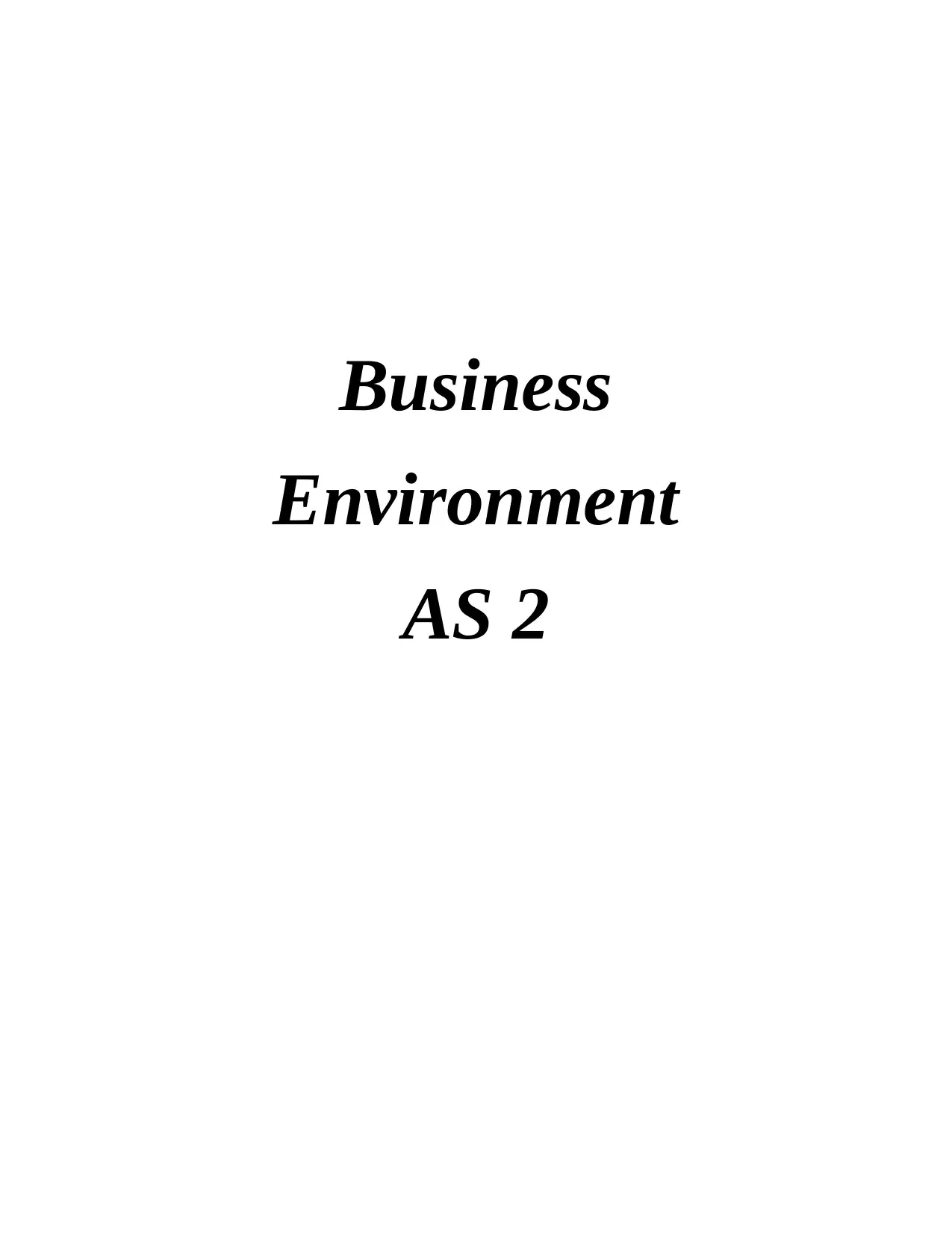
Business
Environment
AS 2
Environment
AS 2
Paraphrase This Document
Need a fresh take? Get an instant paraphrase of this document with our AI Paraphraser
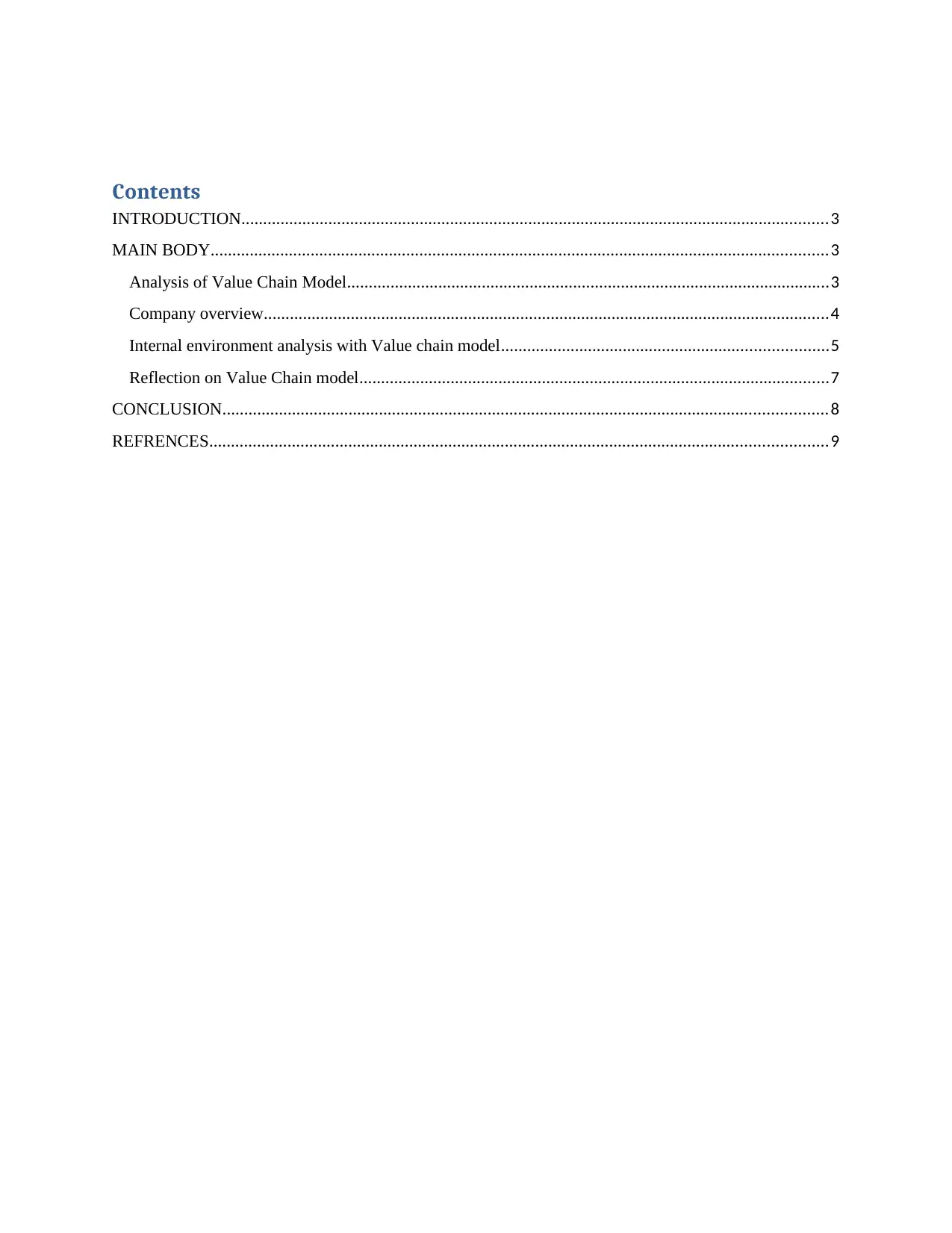
Contents
INTRODUCTION.......................................................................................................................................3
MAIN BODY..............................................................................................................................................3
Analysis of Value Chain Model...............................................................................................................3
Company overview..................................................................................................................................4
Internal environment analysis with Value chain model...........................................................................5
Reflection on Value Chain model............................................................................................................7
CONCLUSION...........................................................................................................................................8
REFRENCES..............................................................................................................................................9
INTRODUCTION.......................................................................................................................................3
MAIN BODY..............................................................................................................................................3
Analysis of Value Chain Model...............................................................................................................3
Company overview..................................................................................................................................4
Internal environment analysis with Value chain model...........................................................................5
Reflection on Value Chain model............................................................................................................7
CONCLUSION...........................................................................................................................................8
REFRENCES..............................................................................................................................................9
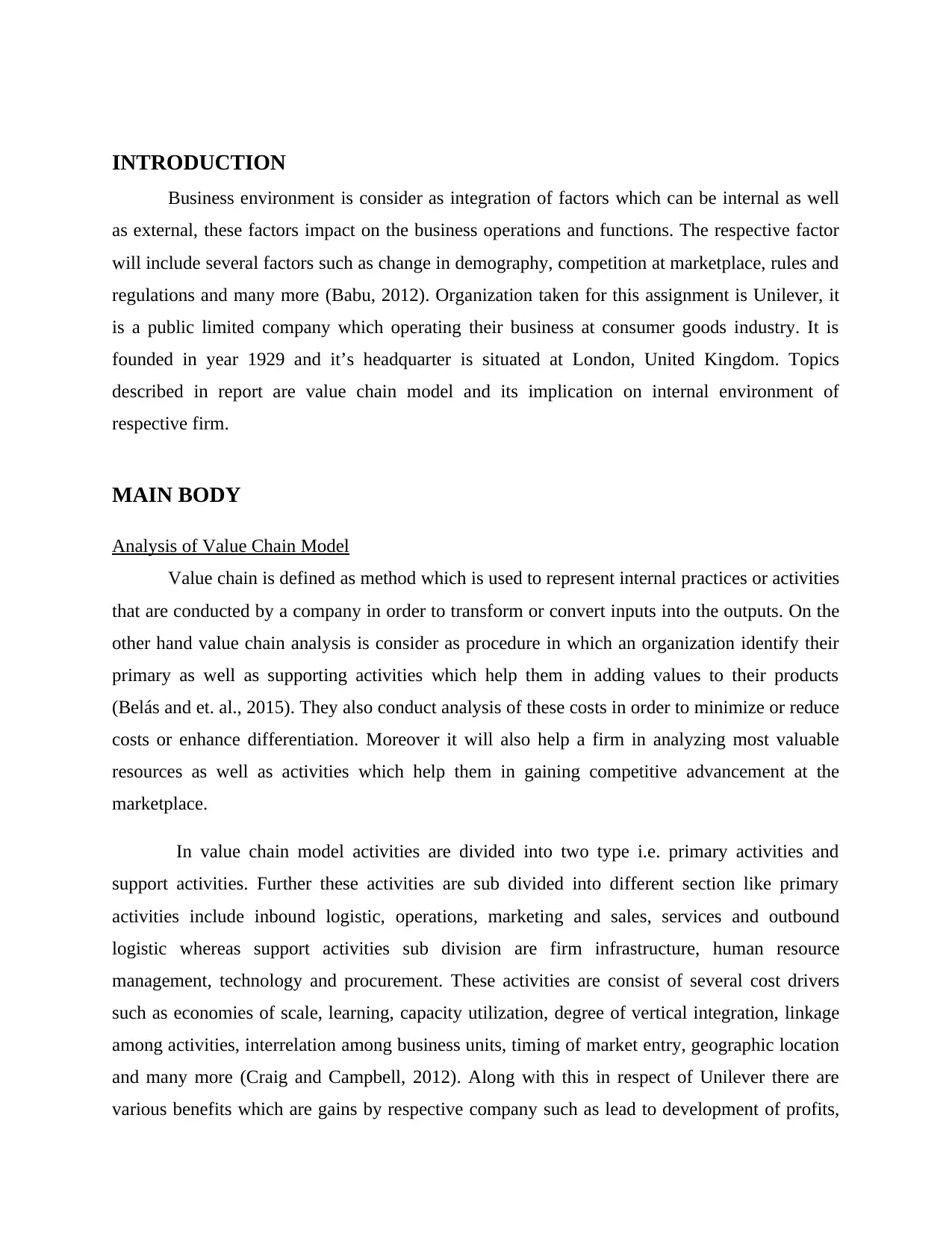
INTRODUCTION
Business environment is consider as integration of factors which can be internal as well
as external, these factors impact on the business operations and functions. The respective factor
will include several factors such as change in demography, competition at marketplace, rules and
regulations and many more (Babu, 2012). Organization taken for this assignment is Unilever, it
is a public limited company which operating their business at consumer goods industry. It is
founded in year 1929 and it’s headquarter is situated at London, United Kingdom. Topics
described in report are value chain model and its implication on internal environment of
respective firm.
MAIN BODY
Analysis of Value Chain Model
Value chain is defined as method which is used to represent internal practices or activities
that are conducted by a company in order to transform or convert inputs into the outputs. On the
other hand value chain analysis is consider as procedure in which an organization identify their
primary as well as supporting activities which help them in adding values to their products
(Belás and et. al., 2015). They also conduct analysis of these costs in order to minimize or reduce
costs or enhance differentiation. Moreover it will also help a firm in analyzing most valuable
resources as well as activities which help them in gaining competitive advancement at the
marketplace.
In value chain model activities are divided into two type i.e. primary activities and
support activities. Further these activities are sub divided into different section like primary
activities include inbound logistic, operations, marketing and sales, services and outbound
logistic whereas support activities sub division are firm infrastructure, human resource
management, technology and procurement. These activities are consist of several cost drivers
such as economies of scale, learning, capacity utilization, degree of vertical integration, linkage
among activities, interrelation among business units, timing of market entry, geographic location
and many more (Craig and Campbell, 2012). Along with this in respect of Unilever there are
various benefits which are gains by respective company such as lead to development of profits,
Business environment is consider as integration of factors which can be internal as well
as external, these factors impact on the business operations and functions. The respective factor
will include several factors such as change in demography, competition at marketplace, rules and
regulations and many more (Babu, 2012). Organization taken for this assignment is Unilever, it
is a public limited company which operating their business at consumer goods industry. It is
founded in year 1929 and it’s headquarter is situated at London, United Kingdom. Topics
described in report are value chain model and its implication on internal environment of
respective firm.
MAIN BODY
Analysis of Value Chain Model
Value chain is defined as method which is used to represent internal practices or activities
that are conducted by a company in order to transform or convert inputs into the outputs. On the
other hand value chain analysis is consider as procedure in which an organization identify their
primary as well as supporting activities which help them in adding values to their products
(Belás and et. al., 2015). They also conduct analysis of these costs in order to minimize or reduce
costs or enhance differentiation. Moreover it will also help a firm in analyzing most valuable
resources as well as activities which help them in gaining competitive advancement at the
marketplace.
In value chain model activities are divided into two type i.e. primary activities and
support activities. Further these activities are sub divided into different section like primary
activities include inbound logistic, operations, marketing and sales, services and outbound
logistic whereas support activities sub division are firm infrastructure, human resource
management, technology and procurement. These activities are consist of several cost drivers
such as economies of scale, learning, capacity utilization, degree of vertical integration, linkage
among activities, interrelation among business units, timing of market entry, geographic location
and many more (Craig and Campbell, 2012). Along with this in respect of Unilever there are
various benefits which are gains by respective company such as lead to development of profits,
⊘ This is a preview!⊘
Do you want full access?
Subscribe today to unlock all pages.

Trusted by 1+ million students worldwide
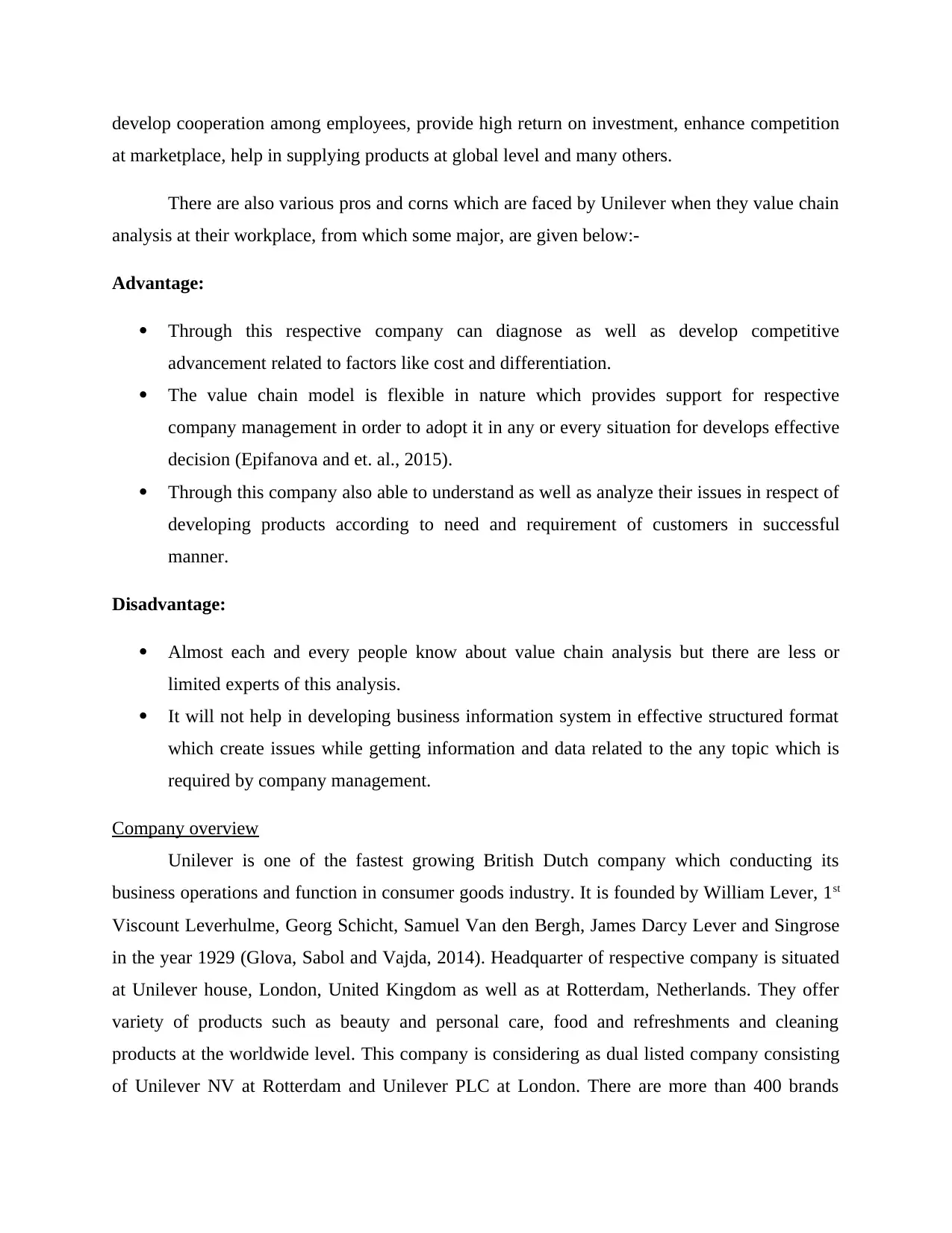
develop cooperation among employees, provide high return on investment, enhance competition
at marketplace, help in supplying products at global level and many others.
There are also various pros and corns which are faced by Unilever when they value chain
analysis at their workplace, from which some major, are given below:-
Advantage:
Through this respective company can diagnose as well as develop competitive
advancement related to factors like cost and differentiation.
The value chain model is flexible in nature which provides support for respective
company management in order to adopt it in any or every situation for develops effective
decision (Epifanova and et. al., 2015).
Through this company also able to understand as well as analyze their issues in respect of
developing products according to need and requirement of customers in successful
manner.
Disadvantage:
Almost each and every people know about value chain analysis but there are less or
limited experts of this analysis.
It will not help in developing business information system in effective structured format
which create issues while getting information and data related to the any topic which is
required by company management.
Company overview
Unilever is one of the fastest growing British Dutch company which conducting its
business operations and function in consumer goods industry. It is founded by William Lever, 1st
Viscount Leverhulme, Georg Schicht, Samuel Van den Bergh, James Darcy Lever and Singrose
in the year 1929 (Glova, Sabol and Vajda, 2014). Headquarter of respective company is situated
at Unilever house, London, United Kingdom as well as at Rotterdam, Netherlands. They offer
variety of products such as beauty and personal care, food and refreshments and cleaning
products at the worldwide level. This company is considering as dual listed company consisting
of Unilever NV at Rotterdam and Unilever PLC at London. There are more than 400 brands
at marketplace, help in supplying products at global level and many others.
There are also various pros and corns which are faced by Unilever when they value chain
analysis at their workplace, from which some major, are given below:-
Advantage:
Through this respective company can diagnose as well as develop competitive
advancement related to factors like cost and differentiation.
The value chain model is flexible in nature which provides support for respective
company management in order to adopt it in any or every situation for develops effective
decision (Epifanova and et. al., 2015).
Through this company also able to understand as well as analyze their issues in respect of
developing products according to need and requirement of customers in successful
manner.
Disadvantage:
Almost each and every people know about value chain analysis but there are less or
limited experts of this analysis.
It will not help in developing business information system in effective structured format
which create issues while getting information and data related to the any topic which is
required by company management.
Company overview
Unilever is one of the fastest growing British Dutch company which conducting its
business operations and function in consumer goods industry. It is founded by William Lever, 1st
Viscount Leverhulme, Georg Schicht, Samuel Van den Bergh, James Darcy Lever and Singrose
in the year 1929 (Glova, Sabol and Vajda, 2014). Headquarter of respective company is situated
at Unilever house, London, United Kingdom as well as at Rotterdam, Netherlands. They offer
variety of products such as beauty and personal care, food and refreshments and cleaning
products at the worldwide level. This company is considering as dual listed company consisting
of Unilever NV at Rotterdam and Unilever PLC at London. There are more than 400 brands
Paraphrase This Document
Need a fresh take? Get an instant paraphrase of this document with our AI Paraphraser
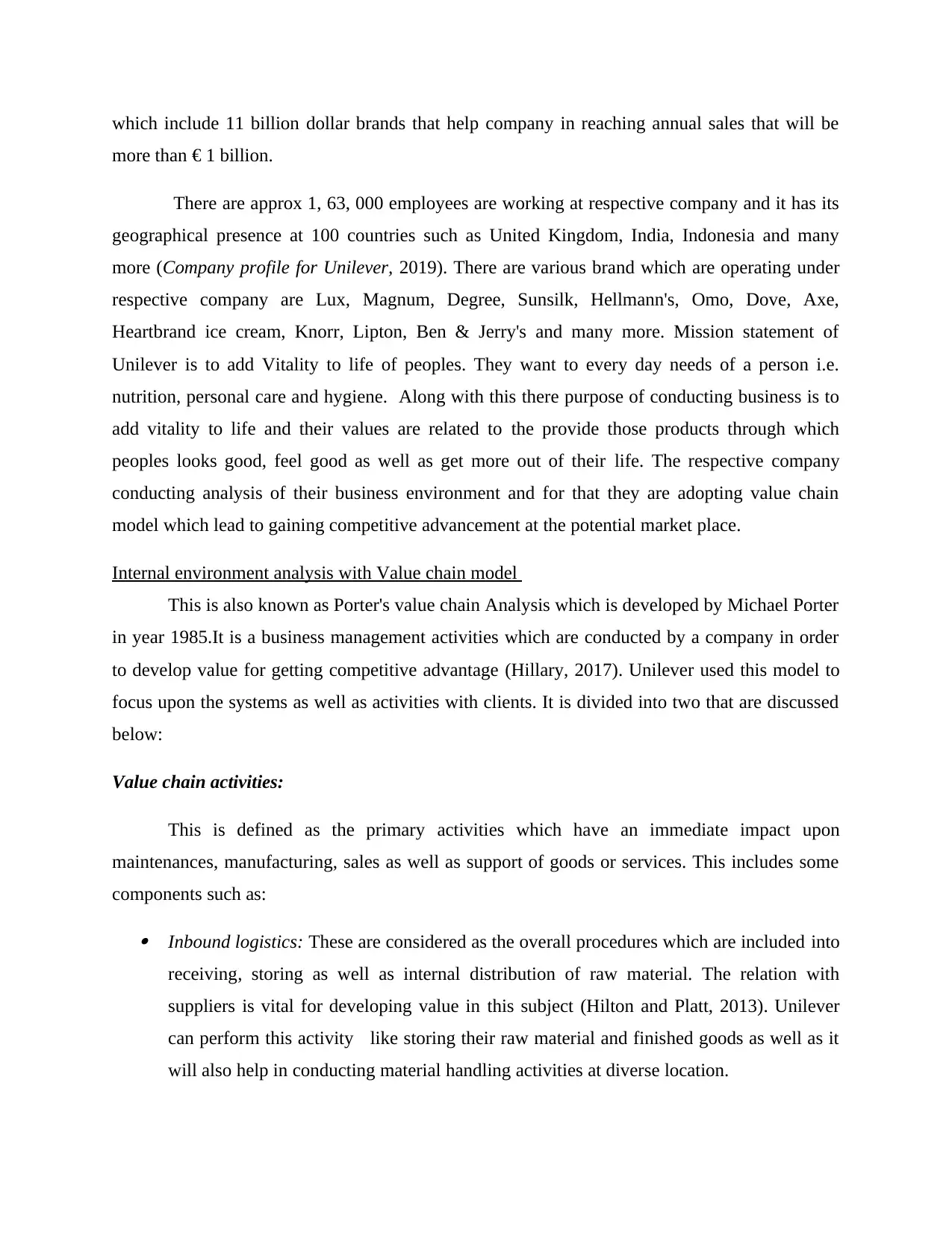
which include 11 billion dollar brands that help company in reaching annual sales that will be
more than € 1 billion.
There are approx 1, 63, 000 employees are working at respective company and it has its
geographical presence at 100 countries such as United Kingdom, India, Indonesia and many
more (Company profile for Unilever, 2019). There are various brand which are operating under
respective company are Lux, Magnum, Degree, Sunsilk, Hellmann's, Omo, Dove, Axe,
Heartbrand ice cream, Knorr, Lipton, Ben & Jerry's and many more. Mission statement of
Unilever is to add Vitality to life of peoples. They want to every day needs of a person i.e.
nutrition, personal care and hygiene. Along with this there purpose of conducting business is to
add vitality to life and their values are related to the provide those products through which
peoples looks good, feel good as well as get more out of their life. The respective company
conducting analysis of their business environment and for that they are adopting value chain
model which lead to gaining competitive advancement at the potential market place.
Internal environment analysis with Value chain model
This is also known as Porter's value chain Analysis which is developed by Michael Porter
in year 1985.It is a business management activities which are conducted by a company in order
to develop value for getting competitive advantage (Hillary, 2017). Unilever used this model to
focus upon the systems as well as activities with clients. It is divided into two that are discussed
below:
Value chain activities:
This is defined as the primary activities which have an immediate impact upon
maintenances, manufacturing, sales as well as support of goods or services. This includes some
components such as:
Inbound logistics: These are considered as the overall procedures which are included into
receiving, storing as well as internal distribution of raw material. The relation with
suppliers is vital for developing value in this subject (Hilton and Platt, 2013). Unilever
can perform this activity like storing their raw material and finished goods as well as it
will also help in conducting material handling activities at diverse location.
more than € 1 billion.
There are approx 1, 63, 000 employees are working at respective company and it has its
geographical presence at 100 countries such as United Kingdom, India, Indonesia and many
more (Company profile for Unilever, 2019). There are various brand which are operating under
respective company are Lux, Magnum, Degree, Sunsilk, Hellmann's, Omo, Dove, Axe,
Heartbrand ice cream, Knorr, Lipton, Ben & Jerry's and many more. Mission statement of
Unilever is to add Vitality to life of peoples. They want to every day needs of a person i.e.
nutrition, personal care and hygiene. Along with this there purpose of conducting business is to
add vitality to life and their values are related to the provide those products through which
peoples looks good, feel good as well as get more out of their life. The respective company
conducting analysis of their business environment and for that they are adopting value chain
model which lead to gaining competitive advancement at the potential market place.
Internal environment analysis with Value chain model
This is also known as Porter's value chain Analysis which is developed by Michael Porter
in year 1985.It is a business management activities which are conducted by a company in order
to develop value for getting competitive advantage (Hillary, 2017). Unilever used this model to
focus upon the systems as well as activities with clients. It is divided into two that are discussed
below:
Value chain activities:
This is defined as the primary activities which have an immediate impact upon
maintenances, manufacturing, sales as well as support of goods or services. This includes some
components such as:
Inbound logistics: These are considered as the overall procedures which are included into
receiving, storing as well as internal distribution of raw material. The relation with
suppliers is vital for developing value in this subject (Hilton and Platt, 2013). Unilever
can perform this activity like storing their raw material and finished goods as well as it
will also help in conducting material handling activities at diverse location.
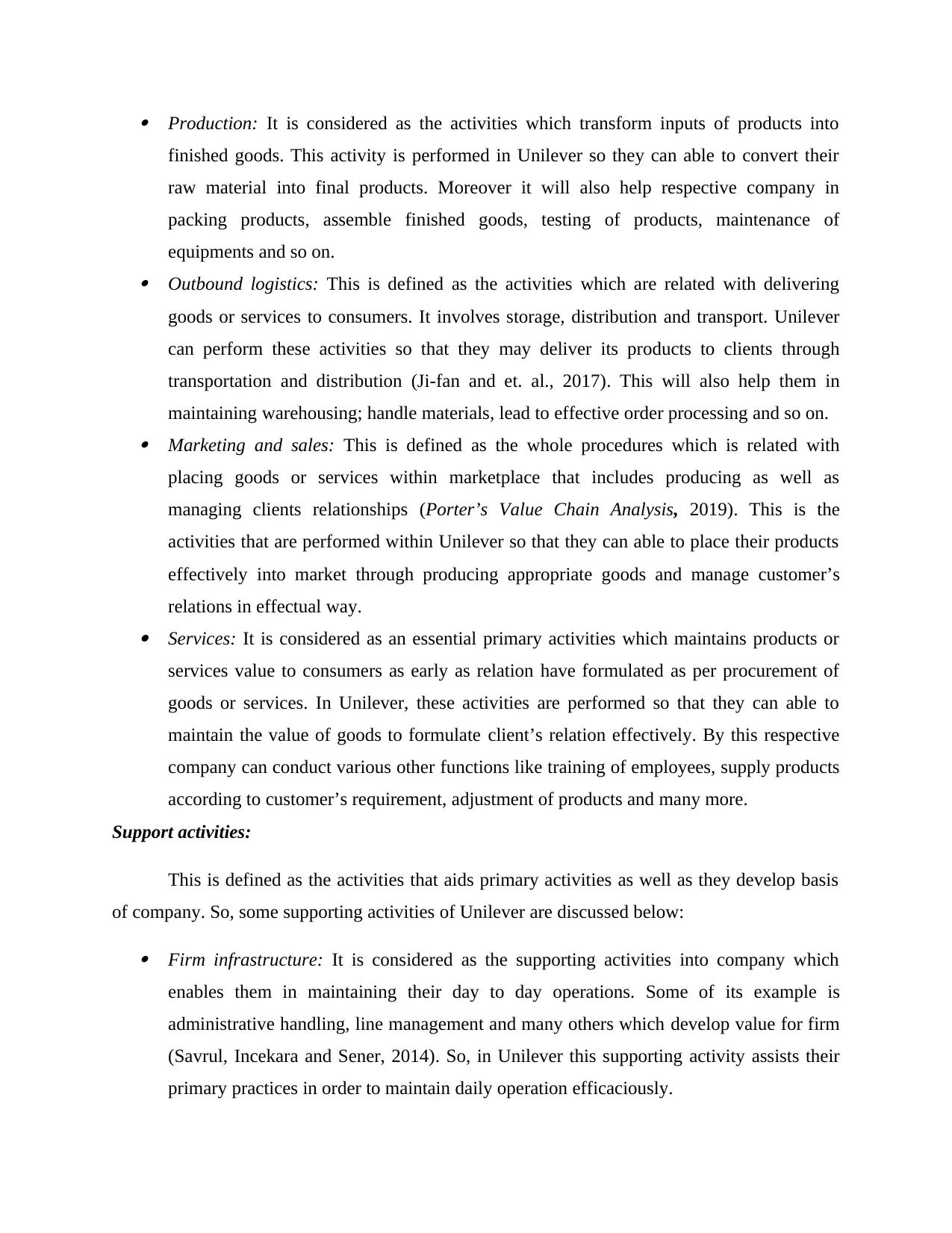
Production: It is considered as the activities which transform inputs of products into
finished goods. This activity is performed in Unilever so they can able to convert their
raw material into final products. Moreover it will also help respective company in
packing products, assemble finished goods, testing of products, maintenance of
equipments and so on. Outbound logistics: This is defined as the activities which are related with delivering
goods or services to consumers. It involves storage, distribution and transport. Unilever
can perform these activities so that they may deliver its products to clients through
transportation and distribution (Ji-fan and et. al., 2017). This will also help them in
maintaining warehousing; handle materials, lead to effective order processing and so on. Marketing and sales: This is defined as the whole procedures which is related with
placing goods or services within marketplace that includes producing as well as
managing clients relationships (Porter’s Value Chain Analysis, 2019). This is the
activities that are performed within Unilever so that they can able to place their products
effectively into market through producing appropriate goods and manage customer’s
relations in effectual way. Services: It is considered as an essential primary activities which maintains products or
services value to consumers as early as relation have formulated as per procurement of
goods or services. In Unilever, these activities are performed so that they can able to
maintain the value of goods to formulate client’s relation effectively. By this respective
company can conduct various other functions like training of employees, supply products
according to customer’s requirement, adjustment of products and many more.
Support activities:
This is defined as the activities that aids primary activities as well as they develop basis
of company. So, some supporting activities of Unilever are discussed below:
Firm infrastructure: It is considered as the supporting activities into company which
enables them in maintaining their day to day operations. Some of its example is
administrative handling, line management and many others which develop value for firm
(Savrul, Incekara and Sener, 2014). So, in Unilever this supporting activity assists their
primary practices in order to maintain daily operation efficaciously.
finished goods. This activity is performed in Unilever so they can able to convert their
raw material into final products. Moreover it will also help respective company in
packing products, assemble finished goods, testing of products, maintenance of
equipments and so on. Outbound logistics: This is defined as the activities which are related with delivering
goods or services to consumers. It involves storage, distribution and transport. Unilever
can perform these activities so that they may deliver its products to clients through
transportation and distribution (Ji-fan and et. al., 2017). This will also help them in
maintaining warehousing; handle materials, lead to effective order processing and so on. Marketing and sales: This is defined as the whole procedures which is related with
placing goods or services within marketplace that includes producing as well as
managing clients relationships (Porter’s Value Chain Analysis, 2019). This is the
activities that are performed within Unilever so that they can able to place their products
effectively into market through producing appropriate goods and manage customer’s
relations in effectual way. Services: It is considered as an essential primary activities which maintains products or
services value to consumers as early as relation have formulated as per procurement of
goods or services. In Unilever, these activities are performed so that they can able to
maintain the value of goods to formulate client’s relation effectively. By this respective
company can conduct various other functions like training of employees, supply products
according to customer’s requirement, adjustment of products and many more.
Support activities:
This is defined as the activities that aids primary activities as well as they develop basis
of company. So, some supporting activities of Unilever are discussed below:
Firm infrastructure: It is considered as the supporting activities into company which
enables them in maintaining their day to day operations. Some of its example is
administrative handling, line management and many others which develop value for firm
(Savrul, Incekara and Sener, 2014). So, in Unilever this supporting activity assists their
primary practices in order to maintain daily operation efficaciously.
⊘ This is a preview!⊘
Do you want full access?
Subscribe today to unlock all pages.

Trusted by 1+ million students worldwide
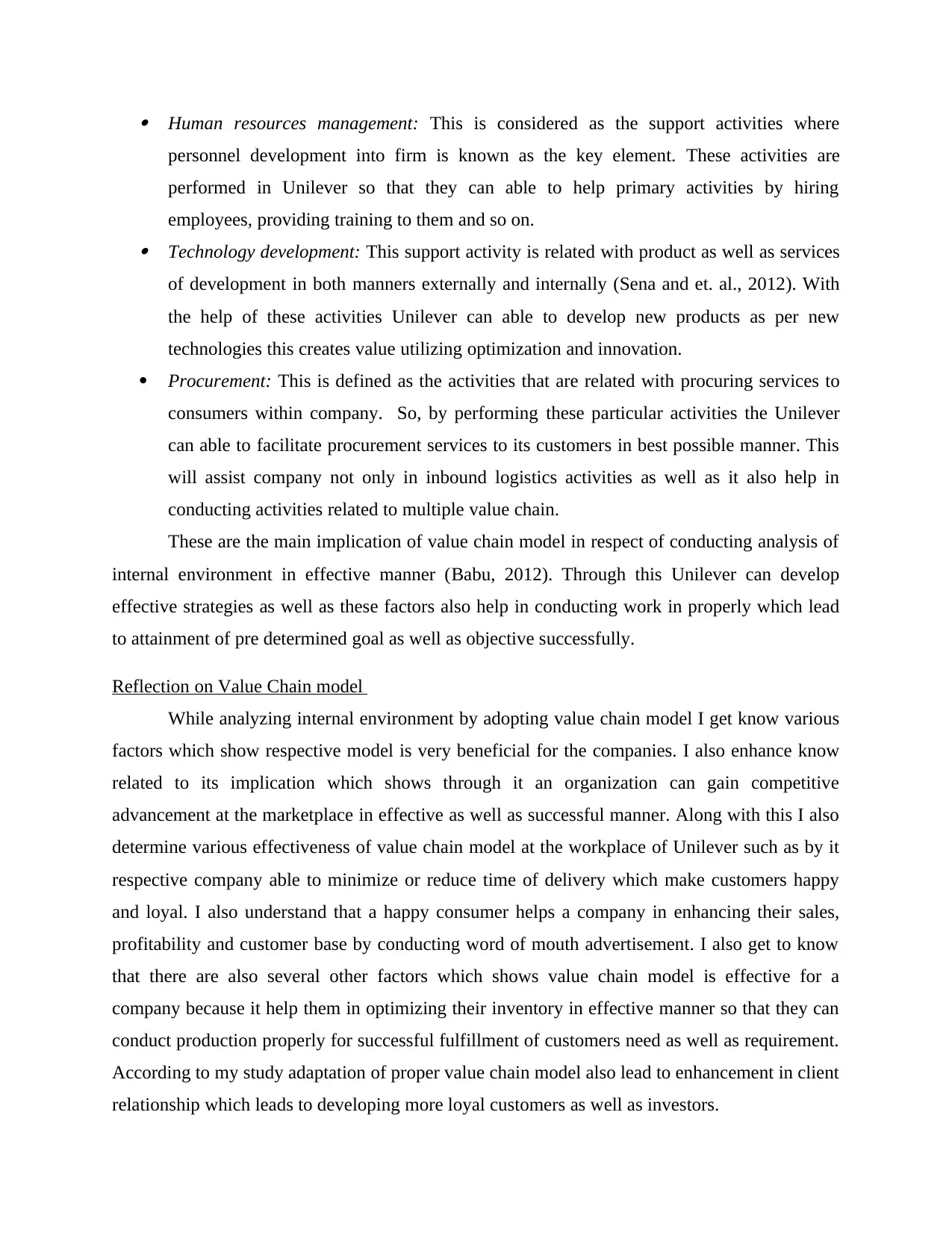
Human resources management: This is considered as the support activities where
personnel development into firm is known as the key element. These activities are
performed in Unilever so that they can able to help primary activities by hiring
employees, providing training to them and so on. Technology development: This support activity is related with product as well as services
of development in both manners externally and internally (Sena and et. al., 2012). With
the help of these activities Unilever can able to develop new products as per new
technologies this creates value utilizing optimization and innovation.
Procurement: This is defined as the activities that are related with procuring services to
consumers within company. So, by performing these particular activities the Unilever
can able to facilitate procurement services to its customers in best possible manner. This
will assist company not only in inbound logistics activities as well as it also help in
conducting activities related to multiple value chain.
These are the main implication of value chain model in respect of conducting analysis of
internal environment in effective manner (Babu, 2012). Through this Unilever can develop
effective strategies as well as these factors also help in conducting work in properly which lead
to attainment of pre determined goal as well as objective successfully.
Reflection on Value Chain model
While analyzing internal environment by adopting value chain model I get know various
factors which show respective model is very beneficial for the companies. I also enhance know
related to its implication which shows through it an organization can gain competitive
advancement at the marketplace in effective as well as successful manner. Along with this I also
determine various effectiveness of value chain model at the workplace of Unilever such as by it
respective company able to minimize or reduce time of delivery which make customers happy
and loyal. I also understand that a happy consumer helps a company in enhancing their sales,
profitability and customer base by conducting word of mouth advertisement. I also get to know
that there are also several other factors which shows value chain model is effective for a
company because it help them in optimizing their inventory in effective manner so that they can
conduct production properly for successful fulfillment of customers need as well as requirement.
According to my study adaptation of proper value chain model also lead to enhancement in client
relationship which leads to developing more loyal customers as well as investors.
personnel development into firm is known as the key element. These activities are
performed in Unilever so that they can able to help primary activities by hiring
employees, providing training to them and so on. Technology development: This support activity is related with product as well as services
of development in both manners externally and internally (Sena and et. al., 2012). With
the help of these activities Unilever can able to develop new products as per new
technologies this creates value utilizing optimization and innovation.
Procurement: This is defined as the activities that are related with procuring services to
consumers within company. So, by performing these particular activities the Unilever
can able to facilitate procurement services to its customers in best possible manner. This
will assist company not only in inbound logistics activities as well as it also help in
conducting activities related to multiple value chain.
These are the main implication of value chain model in respect of conducting analysis of
internal environment in effective manner (Babu, 2012). Through this Unilever can develop
effective strategies as well as these factors also help in conducting work in properly which lead
to attainment of pre determined goal as well as objective successfully.
Reflection on Value Chain model
While analyzing internal environment by adopting value chain model I get know various
factors which show respective model is very beneficial for the companies. I also enhance know
related to its implication which shows through it an organization can gain competitive
advancement at the marketplace in effective as well as successful manner. Along with this I also
determine various effectiveness of value chain model at the workplace of Unilever such as by it
respective company able to minimize or reduce time of delivery which make customers happy
and loyal. I also understand that a happy consumer helps a company in enhancing their sales,
profitability and customer base by conducting word of mouth advertisement. I also get to know
that there are also several other factors which shows value chain model is effective for a
company because it help them in optimizing their inventory in effective manner so that they can
conduct production properly for successful fulfillment of customers need as well as requirement.
According to my study adaptation of proper value chain model also lead to enhancement in client
relationship which leads to developing more loyal customers as well as investors.
Paraphrase This Document
Need a fresh take? Get an instant paraphrase of this document with our AI Paraphraser
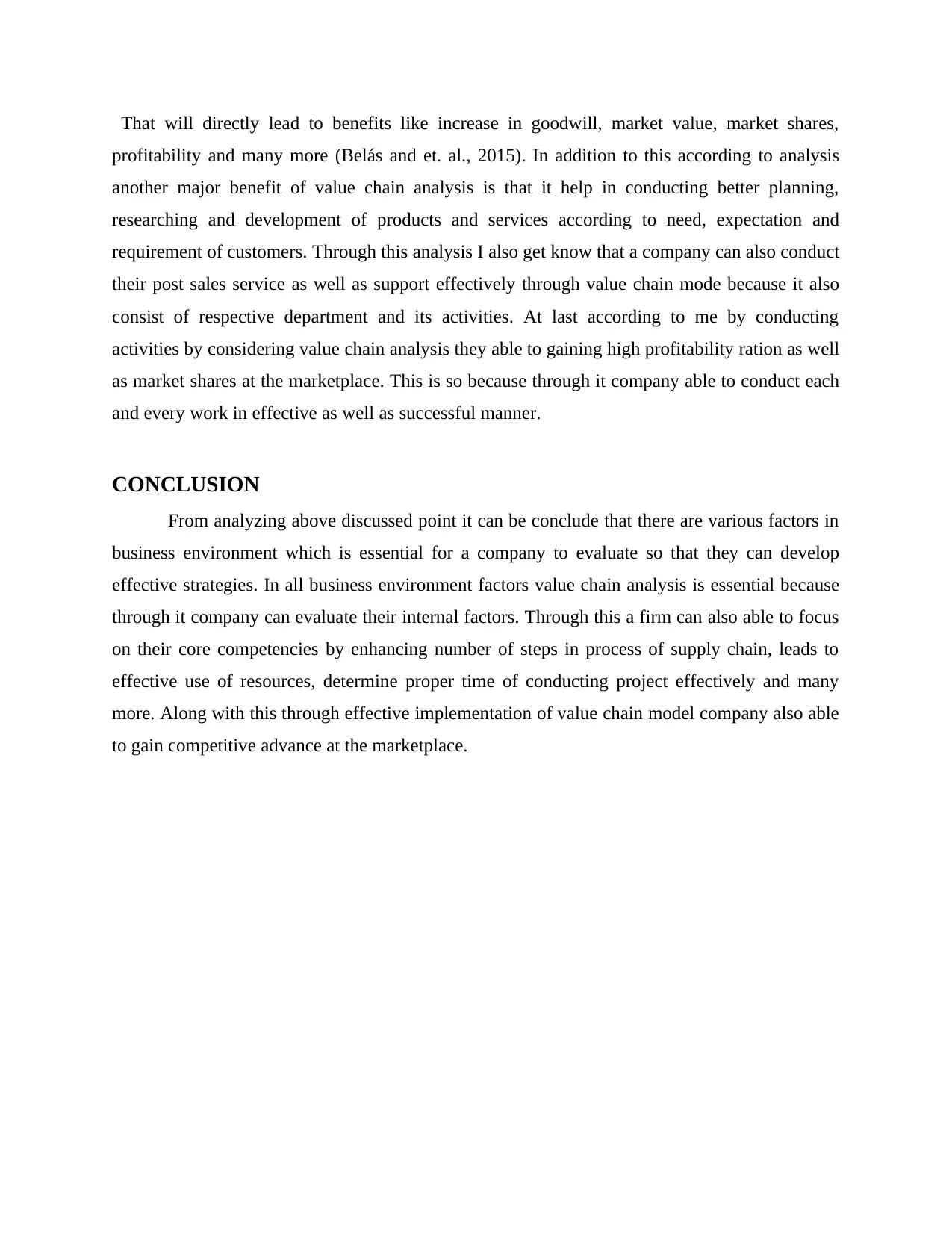
That will directly lead to benefits like increase in goodwill, market value, market shares,
profitability and many more (Belás and et. al., 2015). In addition to this according to analysis
another major benefit of value chain analysis is that it help in conducting better planning,
researching and development of products and services according to need, expectation and
requirement of customers. Through this analysis I also get know that a company can also conduct
their post sales service as well as support effectively through value chain mode because it also
consist of respective department and its activities. At last according to me by conducting
activities by considering value chain analysis they able to gaining high profitability ration as well
as market shares at the marketplace. This is so because through it company able to conduct each
and every work in effective as well as successful manner.
CONCLUSION
From analyzing above discussed point it can be conclude that there are various factors in
business environment which is essential for a company to evaluate so that they can develop
effective strategies. In all business environment factors value chain analysis is essential because
through it company can evaluate their internal factors. Through this a firm can also able to focus
on their core competencies by enhancing number of steps in process of supply chain, leads to
effective use of resources, determine proper time of conducting project effectively and many
more. Along with this through effective implementation of value chain model company also able
to gain competitive advance at the marketplace.
profitability and many more (Belás and et. al., 2015). In addition to this according to analysis
another major benefit of value chain analysis is that it help in conducting better planning,
researching and development of products and services according to need, expectation and
requirement of customers. Through this analysis I also get know that a company can also conduct
their post sales service as well as support effectively through value chain mode because it also
consist of respective department and its activities. At last according to me by conducting
activities by considering value chain analysis they able to gaining high profitability ration as well
as market shares at the marketplace. This is so because through it company able to conduct each
and every work in effective as well as successful manner.
CONCLUSION
From analyzing above discussed point it can be conclude that there are various factors in
business environment which is essential for a company to evaluate so that they can develop
effective strategies. In all business environment factors value chain analysis is essential because
through it company can evaluate their internal factors. Through this a firm can also able to focus
on their core competencies by enhancing number of steps in process of supply chain, leads to
effective use of resources, determine proper time of conducting project effectively and many
more. Along with this through effective implementation of value chain model company also able
to gain competitive advance at the marketplace.
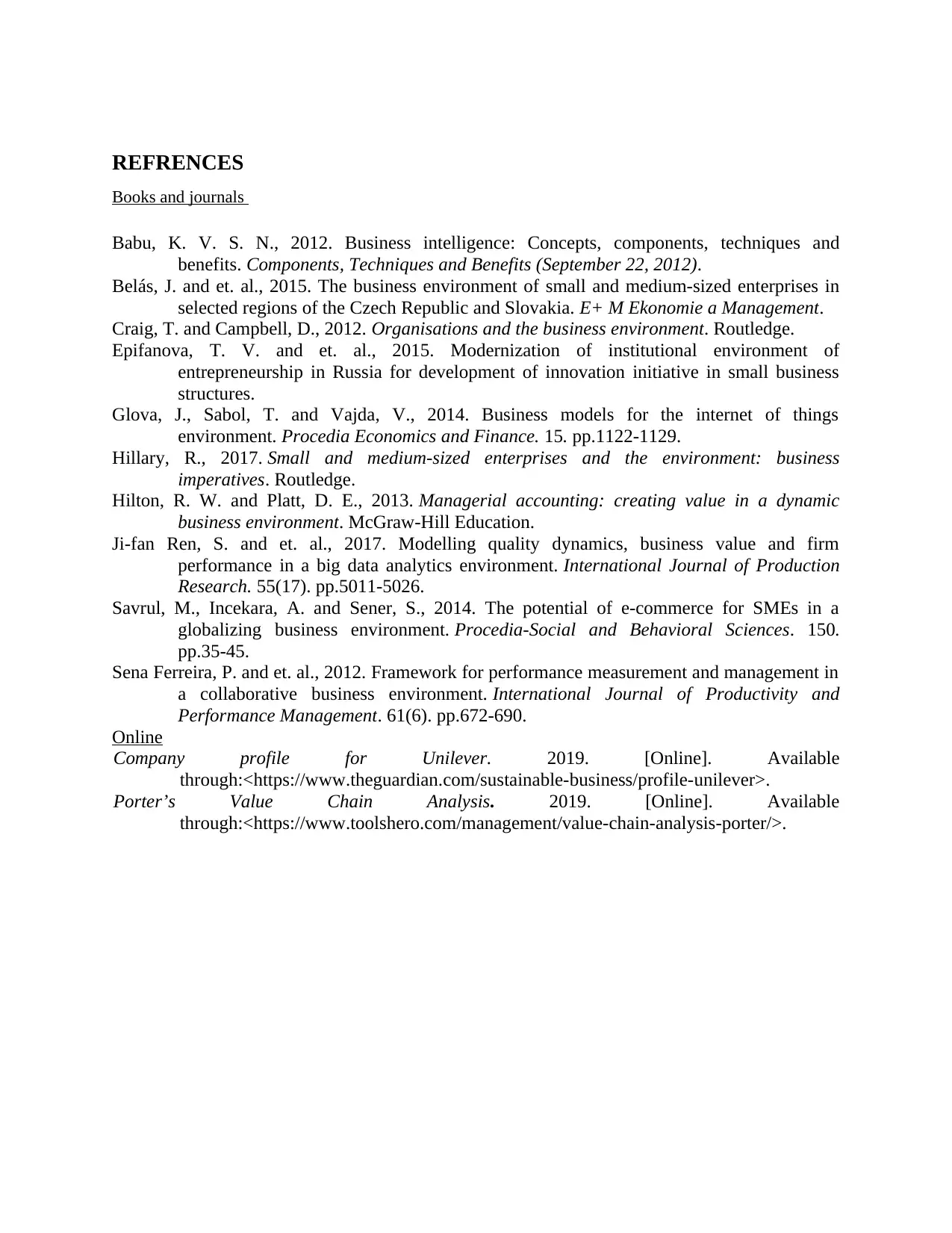
REFRENCES
Books and journals
Babu, K. V. S. N., 2012. Business intelligence: Concepts, components, techniques and
benefits. Components, Techniques and Benefits (September 22, 2012).
Belás, J. and et. al., 2015. The business environment of small and medium-sized enterprises in
selected regions of the Czech Republic and Slovakia. E+ M Ekonomie a Management.
Craig, T. and Campbell, D., 2012. Organisations and the business environment. Routledge.
Epifanova, T. V. and et. al., 2015. Modernization of institutional environment of
entrepreneurship in Russia for development of innovation initiative in small business
structures.
Glova, J., Sabol, T. and Vajda, V., 2014. Business models for the internet of things
environment. Procedia Economics and Finance. 15. pp.1122-1129.
Hillary, R., 2017. Small and medium-sized enterprises and the environment: business
imperatives. Routledge.
Hilton, R. W. and Platt, D. E., 2013. Managerial accounting: creating value in a dynamic
business environment. McGraw-Hill Education.
Ji-fan Ren, S. and et. al., 2017. Modelling quality dynamics, business value and firm
performance in a big data analytics environment. International Journal of Production
Research. 55(17). pp.5011-5026.
Savrul, M., Incekara, A. and Sener, S., 2014. The potential of e-commerce for SMEs in a
globalizing business environment. Procedia-Social and Behavioral Sciences. 150.
pp.35-45.
Sena Ferreira, P. and et. al., 2012. Framework for performance measurement and management in
a collaborative business environment. International Journal of Productivity and
Performance Management. 61(6). pp.672-690.
Online
Company profile for Unilever. 2019. [Online]. Available
through:<https://www.theguardian.com/sustainable-business/profile-unilever>.
Porter’s Value Chain Analysis. 2019. [Online]. Available
through:<https://www.toolshero.com/management/value-chain-analysis-porter/>.
Books and journals
Babu, K. V. S. N., 2012. Business intelligence: Concepts, components, techniques and
benefits. Components, Techniques and Benefits (September 22, 2012).
Belás, J. and et. al., 2015. The business environment of small and medium-sized enterprises in
selected regions of the Czech Republic and Slovakia. E+ M Ekonomie a Management.
Craig, T. and Campbell, D., 2012. Organisations and the business environment. Routledge.
Epifanova, T. V. and et. al., 2015. Modernization of institutional environment of
entrepreneurship in Russia for development of innovation initiative in small business
structures.
Glova, J., Sabol, T. and Vajda, V., 2014. Business models for the internet of things
environment. Procedia Economics and Finance. 15. pp.1122-1129.
Hillary, R., 2017. Small and medium-sized enterprises and the environment: business
imperatives. Routledge.
Hilton, R. W. and Platt, D. E., 2013. Managerial accounting: creating value in a dynamic
business environment. McGraw-Hill Education.
Ji-fan Ren, S. and et. al., 2017. Modelling quality dynamics, business value and firm
performance in a big data analytics environment. International Journal of Production
Research. 55(17). pp.5011-5026.
Savrul, M., Incekara, A. and Sener, S., 2014. The potential of e-commerce for SMEs in a
globalizing business environment. Procedia-Social and Behavioral Sciences. 150.
pp.35-45.
Sena Ferreira, P. and et. al., 2012. Framework for performance measurement and management in
a collaborative business environment. International Journal of Productivity and
Performance Management. 61(6). pp.672-690.
Online
Company profile for Unilever. 2019. [Online]. Available
through:<https://www.theguardian.com/sustainable-business/profile-unilever>.
Porter’s Value Chain Analysis. 2019. [Online]. Available
through:<https://www.toolshero.com/management/value-chain-analysis-porter/>.
⊘ This is a preview!⊘
Do you want full access?
Subscribe today to unlock all pages.

Trusted by 1+ million students worldwide
1 out of 9
Related Documents
Your All-in-One AI-Powered Toolkit for Academic Success.
+13062052269
info@desklib.com
Available 24*7 on WhatsApp / Email
![[object Object]](/_next/static/media/star-bottom.7253800d.svg)
Unlock your academic potential
Copyright © 2020–2025 A2Z Services. All Rights Reserved. Developed and managed by ZUCOL.





